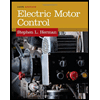
Concept explainers
Explain the necessity of starter on a DC motor.
Explanation of Solution
A starter is an electrical device used to start and accelerate a motor. It is used to limit the inrush current.
Consider the equation of armature current in a DC motor as follows:
Here,
When a motor is started, the armature is stationary at the moment and no counter EMF will be generated. Therefore,
As the counter emf is zero, equation (1) becomes as follows:
Typically, a motor armature resistance is very low. From equation (2), the armature current is inversely proportional to the armature resistance where the armature current is high at the starting of a motor. This high current can create damage to the windings, commutator, and brushes.
Therefore, a starter is used to limit the excessive flow of current and prevent damage to the motor due to the lack of a counter emf and inductive reactance.
Conclusion:
Thus, the necessity of starter on a DC motor is explained.
Want to see more full solutions like this?
Chapter 44 Solutions
EBK ELECTRIC MOTOR CONTROL
- Q1/For the unity-feedback system where G (s) = K(s+ 1)(s+ 10) (s+4) (s-6) Sketch the root locus and find the value of K for which the system is closed-loop stable. Also find the break-in and breakaway points.arrow_forwardThe switch K at Figure 4 is closed at t = 0.2 second. Assuming iL(0) = 0, Find iL(t). 10 Ω w i₁(t) 2ix 20 Ω 2H 10u(t) t = 0.2 s Figure 4 Karrow_forwardThe voltage source in the circuit of Fig. P12.31 is, givenby us(t) = [10+5u(t)] V. Determine iL(t) for t ≥ 0, given thatR1 = 1 W, R2 = 1 W, L = 2 H, and C = 1 F.arrow_forward
- Don't use ai to answer I will report you answerarrow_forwardDetermine iL(t) in the circuit of Fig. P12.25, given thatbefore closing the switch uC(0−)=12 V. Also, the element valuesare R = 2 W, L = 1.5 H, and C = 0.5 F.arrow_forwardThe switch in Figure 5 is closed at t = 0 second. Find the voltage of the capacitor, vc, for t> 0. 8Ω t=0 ww + 0.15H + 24U(-t) 80- 2.5mF VC 2A 0.1H Figure 5arrow_forward
- Q1/For the unity-feedback system where G (s) = K(s+ 1)(s+ 10) (s+4) (s-6) G Sketch the root locus and find the value of K for which the system is closed-loop stable. Also find the break-in and breakaway points.arrow_forward12.22 Repeat Problem 12.21, but assume that the switch hadbeen open for a long time and then closed at t = 0. Set the dcsource at 12 mV and the element values at R0 = 5 W, R1 = 10 W,R2 = 20 W, L = 2 H, and C = 0.4 F. question 21(Determine iL(t) in the circuit of Fig. P12.21 for t ≥ 0,given that the switch was opened at t = 0 after it had been closedfor a long time, us = 12 mV, R0 = 5 W, R1 = 10 W, R2 = 20 W,L = 0.2 H, and C = 6 mF.)arrow_forwardIn Figure 1, by considering reference located at node 4, the voltage nodes will be: V1=4, V2= -5, V3=0.5 volts. If we change the location of reference to node 3, find the values for V1, V2, V4, ix, Vo, Vx and power produced by the current sources without conducting detailed node or mesh analyses. 10 www 4A ww 44 4Q 802 w + Vo 4Q 2 3 3ix Figure 1 ww 4Q 5 W4 1.50arrow_forward
- In the Figure 3 a) Find the values for Vi and ix using nodal analysis. b) Find the produced power by the current source. 50 10Ω www 37A 10Ω 20 5 ix V₁ 200 ix Figure 3 ww 100 + 4V1arrow_forward2) By series and parallel combinations find the equivalent capacitance for this circuit. ||15€ Cequivalent -66 6f 6E 12Farrow_forwardQ2/For the unity-feedback system where G(s) = K/[s (s+3) (s+ 5)], find the range of gain, K, for stability, instability, and the value of gain for marginal stability. For marginal stability also. Use the Nyquist criterion.arrow_forward

 Delmar's Standard Textbook Of ElectricityElectrical EngineeringISBN:9781337900348Author:Stephen L. HermanPublisher:Cengage Learning
Delmar's Standard Textbook Of ElectricityElectrical EngineeringISBN:9781337900348Author:Stephen L. HermanPublisher:Cengage Learning

